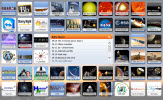July 2023
This month look for the two inner planets, Mercury and Venus, and the terrestrial planet, Mars, to be located above the southwestern horizon at sunset local time. The 'giant' outer ringed planets Jupiter, Saturn, and Uranus all rise before the Sun rises and are above the eastern horizon at sunset. The Earth reaches aphelion, furthest from the Sun this month, on July 6th, but that is an annual thing.
Click here for the month at a glance calendar.

What is this? "It's a prediction of when Lees Summit, MO, will have good weather for astronomical observing." Click on the graphic to go to the Clear Sky web site.

Mercury moves out from the opposite side of the Sun, Superior Conjunction, into the evening skies. The innermost planet will be low above the western horizon but still visible. Watch on around the 15th for Mercury to pass closely by the Beehive Cluster, M-44, and at the end of the month to be in conjunction with Regulus.
Venus continues to outshine all else in the evening skies above the western horizon. However Venus is approaching inferior conjunction next month and so will continue to appear larger but as an increasingly thinner crescent shape.
Mars is still visible over the southwestern horizon at sunset local time. It will be in conjunction with Venus at the start of the month, and with Regulus a few days later.
Dwarf Planet Ceres is located east from the star Denebola, the Lion's tail, but will be too dim to be seen without some sort of optical assistance. On the 23rd the waxing crescent Moon will be a few degrees from Ceres.
Jupiter rises around midnight local time and remains visible above the eastern-southern horizon the rest of the night hours. Watch for a conjunction with the Moon around the 11th.
Saturn is in retrograde motion and is appearing to move westward across the constellation Aquarius the Water Bearer.
Uranus rises before the Sun and is located within the constellation of Aries the Sea-Goat.

















